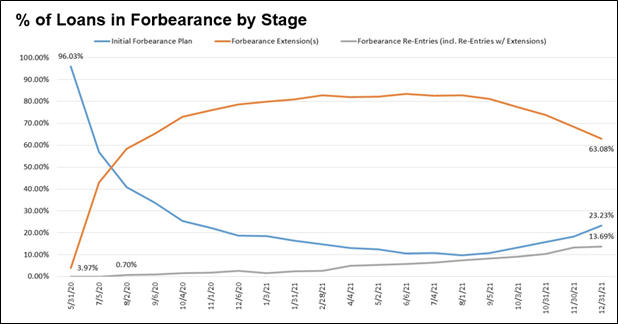 In its latest Loan Monitoring Survey [1], the Mortgage Bankers Association (MBA) reports that the total number of loans now in forbearance decreased by 26 basis points from 1.67% of servicers' portfolio volume in the prior month [2] to 1.41% as of December 31, 2021. The MBA estimates that 705,000 U.S. homeowners are currently in forbearance plans.
In its latest Loan Monitoring Survey [1], the Mortgage Bankers Association (MBA) reports that the total number of loans now in forbearance decreased by 26 basis points from 1.67% of servicers' portfolio volume in the prior month [2] to 1.41% as of December 31, 2021. The MBA estimates that 705,000 U.S. homeowners are currently in forbearance plans.
By investor type, the share of Ginnie Mae loans in forbearance decreased relative to the prior month [2], dropping 47 basis points from 2.10% to 1.63%. The share of GSE loans (Fannie Mae and Freddie Mac) in forbearance decreased relative to the prior month [2] as well, dipping slightly from 0.76% to 0.68%. The share of portfolio and PLS loans in forbearance decreased relative to the prior month [2], from 3.94% to 3.43%.
"The share of loans in forbearance continued to decline in December 2021. This was especially the case for government and private-label and portfolio loans, as those loans have higher levels of forbearance than loans backed by Fannie Mae and Freddie Mac," said Marina Walsh, CMB, MBA's VP of Industry Analysis.
By stage, 23.2% of total loans in forbearance were in the initial forbearance plan stage, while 63.1% were in a forbearance extension. The remaining 13.7% were forbearance re-entries, including re-entries with extensions.

"It is likely that the remaining borrowers in forbearance have experienced either a permanent hardship that may require more complex loan workout solutions, or they have encountered a recent hardship for which they are now seeking relief,” said Walsh.
Of the cumulative forbearance exits for the period from June 1, 2020 through December 31, 2021, at the time of forbearance exit:
- 29.1% resulted in a loan deferral/partial claim.
- 19.5% represented borrowers who continued to make their monthly payments during their forbearance period.
- 16.9% represented borrowers who did not make all of their monthly payments and exited forbearance without a loss mitigation plan in place yet.
- 14.6% resulted in a loan modification or trial loan modification.
- 11.7% resulted in reinstatements, in which past-due amounts are paid back when exiting forbearance.
- 6.9% resulted in loans paid off through either a refinance or by selling the home.
- The remaining 1.3% resulted in repayment plans, short sales, deed-in-lieus or other reasons.
"With the number of borrowers in forbearance continuing to decrease below 750,000, the pace of monthly forbearance exits reached its lowest level since MBA started tracking exits in June 2020,” said Walsh.
And those forbearance exits may increase over the near term, as the employment situation nationwide continues to improve. According to the U.S. Bureau of Labor Statistics (BLS) [3], total nonfarm payroll employment rose by 199,000 in December, as the unemployment rate dropped to 3.9%. In February 2020, prior to the pandemic, the unemployment rate was at 3.5%, and unemployed persons numbered 5.7 million nationwide.
The MBA also reported that he five states with the highest share of loans that were current as a percent of servicing portfolio included:
- Idaho
- Washington
- Colorado
- Utah
- Oregon
The five states with the lowest share of loans that were current as a percent of servicing portfolio included:
- Louisiana
- Mississippi
- New York
- Illinois
- Indiana